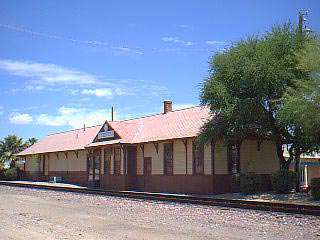Santa Fe Depot
category : Railroad History
 The Santa Fe Depot at Wickenburg, Arizona, was the last of the original wooden depots on the Santa Fe Railroad Line by the 1920s, when Santa Fe decided the "old wooden depot" seemed too outmoded for the progressive Santa Fe Railroad which was replacing the wooden depots at many places down the line, such as, the brick depot in Ashfork and then the "Pan American" stucco structure at Prescott in 1909.
The Santa Fe Depot at Wickenburg, Arizona, was the last of the original wooden depots on the Santa Fe Railroad Line by the 1920s, when Santa Fe decided the "old wooden depot" seemed too outmoded for the progressive Santa Fe Railroad which was replacing the wooden depots at many places down the line, such as, the brick depot in Ashfork and then the "Pan American" stucco structure at Prescott in 1909.In response, the townspeople and the ranchers in the Wickenburg area felt their "Old West" atisan-built wooden depot was an essential part of the atmosphere, both for themselves and their visitors. By May 1969, when the Wickenburg Depot closed to passenger service, the local people immediately began writing to the Santa Fe administrative office in an attempt to obtain the depot for alternative uses. Now listed on the National Register of Historic Places, the depot is leased by the Wickenburg Chamber of Commerce and is recognized as an official Arizona Visitor's Center.
The Town of Wickenburg endured a difficult 30 years for its railroad from 1865 to 1895. After the discovery of the Vulture gold ledge by Henry Wickenburg in 1863, and especially after the sale to a New York company in 1866, and the establishment of the Vulture Mine, there was a necessity for efficient transportation of the heavy gold-bearing ores. The Army Department of the West, covering California and Arizona, needed better and quicker transport, as well.
A legislatively proposed, Wickenburg to Wilmington route never became a reality, and the ore continued to be transported to San Francisco at crippling expense by wagons. The wagons then brought back the limited amount of food stuffs, dry goods, and fuel that a struggling Wickenburg could purchase. Without a railroad, the potential wealth contained in the Vulture simply could not be realized, and by 1875 Vulture Mining Company faced a tax warrant from the sheriff.
In 1877, the Southern Pacific Railroad entered Arizona from California at Yuma, making the Vulture Mine a more feasible venture, because the wagons could reach the new railroad line at Maricopa, Arizona, a 70 mile journey south. James Seymour of New York re-opened the Vulture Mine and by 1879, a 40-stamp mall was built, and gold prospering was renewed at an accelerated pace all over Northern Maricopa and Yavapai counties.
N.O. Murphy was taking care of railroad-enabling legistlation in the form of grants, tax exemptions and helpful freight rate tariffs. By 1881 the partners had started a central Arizona railroad from Askfork to Prescott and they were finally able to get their railroad cars down to the mine at Congress Junction, and eventually into Wickenburg, where the "Peavine" line came through in the Spring of 1895, on its way to Phoenix. By July of that year a wooden depot sheltering the passengers and housing the telegraph and a Wells Fargo office along with other freight was stretched out along Railroad Avenue, now Frontier Street, where it became the center of Wickenburg's social life. Santa Fe took over the railroad in 1903.
Hours: Weekdays, 9am-5pm; Saturday, 9am-3pm, Sunday, 10am-2pm.
Address: Frontier and Yavapai Streets
Phone: 928-684-5479
Historic Walking Tour # 1.
Come visit us in Wickenburg, Arizona